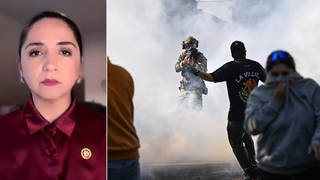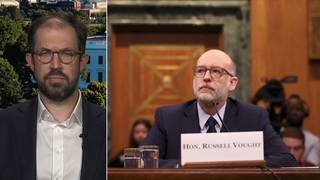
Topics
Guests
- Laura Gottesdienerauthor of A Dream Foreclosed: Black America and the Fight for a Place to Call Home, just published by Zuccotti Park Press. She is also associate editor at Waging Nonviolence.
As President Obama heads to Phoenix today to tout the “housing recovery,” journalist Laura Gottesdiener examines the devastating legacy of the foreclosure crisis and how much of the so-called recovery is a result of large private equity firms buying up hundreds of thousands of foreclosed homes. More than 10 million people across the country have been evicted from their homes in the last six years. Her new book, “A Dream Foreclosed: Black America and the Fight for a Place to Call Home,” focuses on four families who have pushed back against foreclosures. “The banks exploited a larger historical trajectory of discrimination in lending and in housing that has existed since the beginning of this country. The banks intentionally went into communities that had been redlined, which meant that the Federal Housing Administration had made it a policy to not lend and not to guarantee any loans in minority neighborhoods all throughout most of the 20th century that didn’t supposedly end until well into the 1960s,” Gottesdiener says. “And they exploited that historical reality and pushed the worst of the worst loans in these communities that everyone knew were unpayable debts — that Wall Street knew.”
Transcript
AMY GOODMAN: We are going to continue to look at this issue of foreclosures, as we turn now to a new book that documents those who are fighting back. Our guest is Laura Gottesdiener, author of A Dream Foreclosed: Black America and the Fight for a Place to Call Home, which was just published by Zuccotti Park Press. The book follows how people have dealt with the housing crisis within the context of the broader financial collapse, focusing on the story of four families who have pushed back against foreclosures at a time when more than 10 million people across the country have been evicted from their homes in the last six years. Laura is also associate editor at Waging Nonviolence.
Laura, welcome to Democracy Now! It’s a really incredible book. Ten million people foreclosed on, the size of the state of Michigan.
LAURA GOTTESDIENER: Yeah, 10 million. Amy, thank you so much for having me; it’s really a pleasure. I mean, when I was starting to look at these numbers and I saw that we were talking about 10 million people, the number people who currently live in the state of Michigan, I was floored. And the reason I was floored is because we don’t hear that number—ever. And the reason that we don’t measure this crisis in terms of the actual number of people, of families who have been evicted, of missed school days, of destabilized dinners—of the way that human people have actually been affected—is because we don’t value families, we don’t value human life, as much as we value, you know, stock prices, speculation and monetary value of homes. And so, to me, the fact that nobody even knows that 10 million people have been evicted since 2007 betrays the larger, fundamental problem that allowed this crisis to happen in the first place.
AMY GOODMAN: As Clarence Lusane, who writes the foreword to your book, points out in the first sentence, that few recall that one week after Dr. King’s murder, on April 11, 1968, President Lyndon Johnson signed into law the Fair Housing Act, which outlaws discrimination in the sale, rental, financing of dwellings and in other housing-related transactions based on race, color, national origin, religion, sex, familial status or disability. There hasn’t been a Wall Street executive jailed for what has happened to the population, what, 10 million people?
LAURA GOTTESDIENER: Yeah, not a single one. And it’s interesting, because, yes, the Fair Housing Act was signed in 1968, and the Fair Lending Act in 1977, but that didn’t stop the banks from systematically and intentionally discriminating against people on the basis of race. The way that it happened has been incredibly well documented. One loan officer testified that they put—that Wells Fargo put bounties on the heads of minority borrowers by paying cash incentives to loan officers to push those aggressively in minority neighborhoods.
You know, but the thing, too, that I think we’re often reluctant to talk about is the banks exploited a larger historical trajectory of discrimination in lending and in housing that has existed since the beginning of this country. The banks intentionally went into communities that had been redlined, which meant that the Federal Housing Administration, that the government, had made it a policy not to lend and not to guarantee any loans in minority neighborhoods all throughout most of the 20th century, that didn’t end—it didn’t supposedly end until well into the '60s. And they exploited that historical reality to push the worst of the worst loans in these communities, that everyone knew were absolutely unpayable debts, that Wall Street knew. You know, homeowners didn't know, because they weren’t honest—the banks weren’t honest about the terms of the loans. So, we’re seeing both blatant discrimination in the loans given today, but we’re also seeing the exploitation of a history of racial discrimination.
AMY GOODMAN: Yet the buzzword today, Laura, is housing recovery.
LAURA GOTTESDIENER: Right.
AMY GOODMAN: All over in the media they’re showing the map of how housing prices have gone up in Phoenix and San Francisco—and, of course, President Obama is going to be in Phoenix today to highlight this, that it’s all turned around.
LAURA GOTTESDIENER: What we’re talking about when we talk about housing recovery is we’re talking about the rising prices of houses. We’re not talking about a stabilization of the lives of families who have been evicted. We’re not talking about an end to foreclosures. Tens of thousands of foreclosures are still happening every single month across the country. What we’re really talking about, honestly, is large private equity companies, including Blackstone Group, one of the largest private equity companies in the world, making it a point now, making it a policy, to go in and buying huge tracts of land with foreclosed houses. They’ve spent billions of dollars in the last two years buying up hundreds of thousands of foreclosed houses. We don’t know what they’re going to do with them, but I know that that doesn’t signify, to me, a human housing recovery; that signifies, to me, a Wall Street housing recovery.
AMY GOODMAN: In your book, A Dream Foreclosed, you’re not just talking about devastated America; you’re talking about devastated Americans fighting back. Give us examples.
LAURA GOTTESDIENER: Absolutely. I’d be honored, you know, and something that I think people sometimes misunderstood is I didn’t write the book and focus on black America because that community has been the most devastated. I focused on black America because that community has been the most organized in resistance and the most visionary in some of the concrete proposals for how we could restructure ownership and control of land and housing for the future so that this crisis wouldn’t happen again.
So I’m going to tell one story of a woman named Bertha Garrett in Detroit, 65-year-old grandmother, a writer, deeply religious, you know, the mother of six children. When the banks tried to foreclose on her home, that she had lived in for 22 years, she said, “I’m not leaving.” She and her husband, who is now legally blind, said, “We will not leave.” They called up all their friends. Hundreds of people—thanks to the work of Moratorium NOW!, People Before Banks, Occupy Homes Detroit, lots of community groups, hundreds of people amassed on her front lawn, blocked the banks from having the city put the dumpster that is legally required to be there to haul out all of her property, all of the things that she and her family have built over the years. And even more, I think, to me, outstandingly is she, at this time—as hundreds were amassing to block this in an eviction blockade, she was downtown, you know, outside of the office of New York Bank of Mellon, where they refused to even meet with her. They said, “I’m sorry, you don’t have an appointment. We won’t even meet with you to talk about the fact that you’re being thrown out of your home today.” And so, she said, “Well, if I can’t come in, if I can’t come into this office, then nobody can come out.” And she, this 65-year-old deeply religious grandmother, laid down in front of the office of the bank and said, “I’m not moving. I refuse to move.” And the next day, they called her, and they offered to sell her the home for an incredibly affordable rate.
And, to me, that signifies that communities across the country, particularly in African-American neighborhoods, are refusing to move, and they’re saying, “We live in this neighborhood. We should have the right to control what happens in this neighborhood.” And if we talk about community control of land, if we talk about the idea that people who live in this neighborhood should have the right to make decisions about how the land is used, that wouldn’t just help us have a legitimate housing recovery. That would also help us make safer and more informed decisions about economic, environmental policies. Imagine if we made decisions about mining based on what people in that community actually wanted. Imagine if we made decisions about schools, about hospitals, about prisons, all based on what actual communities needed.
AMY GOODMAN: Tell us about Martha Biggs in Chicago, very quickly.
LAURA GOTTESDIENER: Absolutely. Martha Biggs is an incredible mother of four, who spent about a decade homeless on the South Side of Chicago, an incredibly difficult existence. She was first evicted from Cabrini-Green. Then she was later evicted from a rental apartment. And finally, she said, “I don’t want my family to be sleeping in my minivan, and I don’t want these bank-owned homes ruining my neighborhood, dragging down property values, creating crime, creating blight.” So she and some of her neighbors, and with the help of the Chicago Anti-Eviction Campaign, they—and Take Back the Land, a national organization—she rehabbed a bank-owned home, and she and her family liberated it, and now they still live there.
AMY GOODMAN: And what about in North Carolina, where we’re now seeing Moral Mondays, people fighting back?
LAURA GOTTESDIENER: Yeah.
AMY GOODMAN: You tell the story about Griggs Wimbley.
LAURA GOTTESDIENER: Yep, he spent about 10 years legally fighting an incredibly complicated foreclosure, in which he dealt with every single major perpetrator of these crimes—Wells Fargo, GMAC, the robo-signing—everything. He got more than 40 foreclosure filings over the course of a decade. One time he got his foreclosure filing dismissed; two days later, he received a new one in the mail. His story demonstrates the way that Wall Street had actually no idea what they were doing through the foreclosure crisis. And there’s no reason that we should continue to allow them to break these laws.
AMY GOODMAN: In your book, A Dream Foreclosed: Black America and the Fight for a Place to Call Home, there are numerous images of quilts, what are labeled “foreclosure quilts.” Can you talk about how you learned from them and what they are?
LAURA GOTTESDIENER: Absolutely. These quilts, which are created by an artist and a former urban planner called Kathryn Clark—named Kathryn Clark, they stitch the foreclosures in neighborhoods. That one is of Detroit. And you can see every single red square is a foreclosed house. You can see full blocks that have been foreclosed on. To me, I was so struck by these images because they show the real human value, the real human toll that this crisis has taken. It, to me, is an effort, a very beautiful one, to measure this crisis in the real human terms. And that is what I tried to do, too, in this book, both by showing the real human devastation and also showing communities organized in resistance to fight back and imagine a new system.
AMY GOODMAN: Finally, how were you inspired by Occupy Wall Street?
LAURA GOTTESDIENER: I was incredibly inspired by the space that it opened up—I was participating a lot in New York before starting to travel to report for this book—the space it opened up to imagine different ways to organize society. And, for me, the work that these communities, the Take Back the Land, the Chicago Anti-Eviction Campaign, City Life in Boston, all of these groups are doing is imagining a new way we could structure society, a way that is more humane and that values human life over private property.
AMY GOODMAN: Well, Laura Gottesdiener, I want to thank you very much for being with us. The book is called A Dream Foreclosed: Black America and the Fight for a Place to Call Home, just published by Zuccotti Park Press. She is also associate editor at Waging Nonviolence.
I’ll be speaking tonight in Manhasset at the Unitarian Church at Shelter Rock at 7:00.












Media Options